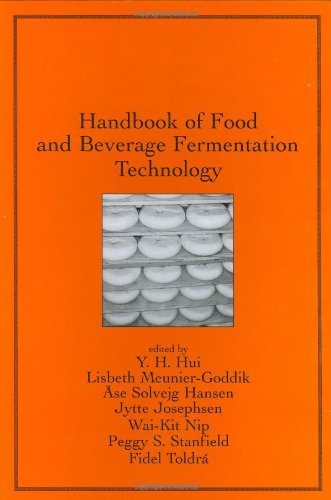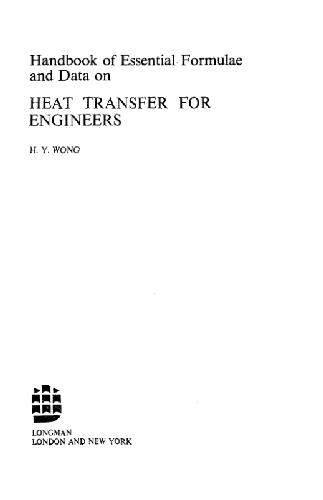Y. H. Hui, Lisbeth Meunier-Goddik, Ase Slovejg Hansen, Jytte Josephsen, Wai-Kit Nip, Peggy S. Stanfield, Fidel Toldra9780824747800, 0-8247-4780-1
Table of contents :
Handbook Of Food And Beverage Fermentation Technology……Page 1
Food Science And Technology……Page 3
Additional Volumes In Preparation……Page 8
Preface……Page 9
Contents……Page 11
Contributors……Page 15
Contents……Page 0
I. INTRODUCTION……Page 19
A. Alcoholic Fermentations……Page 20
B. Vinegar—the Acetic Acid Fermentation……Page 21
C. Fermentations Yielding Meat-like Textures……Page 22
D. Lactic Acid Fermentations……Page 23
REFERENCES……Page 24
A. Traditional Food Fermentations……Page 26
A. Yeast, Molds, and Bacteria……Page 27
B. Taxonomy……Page 28
B. Biopreservation……Page 32
A. Production of Starter Cultures……Page 33
C. Quality and Safety of Industrially Produced Cultures……Page 34
VI. INNOVATION TRENDS……Page 35
REFERENCES……Page 36
I. INTRODUCTION……Page 40
II. FERMENTATION PROCESSES……Page 42
B. Cultures for Milk Fermentation……Page 43
C. Cultures for Fermentation of Vegetables, Fruits, and Grains……Page 47
D. Cultures for Meat Fermentation……Page 48
A. Introduction……Page 49
B. Brewing Yeasts……Page 50
C. Winery Yeasts and Yeasts Used for the Production of Distilled Alcohols……Page 52
E. Yeasts Used for Dairy Products……Page 53
F. Yeasts Used for Meat Products……Page 54
A. Introduction……Page 55
B. Molds Used for Dairy Products……Page 56
E. Molds Used for Fermentation of Indigenous Fermented Foods and Beverages……Page 57
REFERENCES……Page 58
A. Ingredients and Kinds of Products……Page 68
B. Cheeses……Page 71
1. Cottage Cheese Manufacturing……Page 75
3. Swiss Cheese Manufacturing……Page 76
4. Blue Cheese……Page 77
6. Feta Cheese Manufacturing……Page 78
C. Yogurt……Page 79
D. Fermented Liquid Milks……Page 80
2. Kefir……Page 82
3. Acidophilus Milk……Page 83
B. Hams……Page 85
C. Sausages……Page 86
A. Products and Ingredients……Page 87
B. Regular Bread……Page 88
F. Steamed Bread (Mantou)……Page 90
A. Products and Ingredients……Page 93
2. Hama-natto and Dou-chi……Page 94
D. Fermented Soy Pastes……Page 95
1. Sufu or Fermented Soy Cheese……Page 96
2. Stinky Tofu……Page 98
B. Sauerkraut……Page 99
C. Pickles……Page 100
E. Chinese Pickled Vegetables……Page 101
VII. APPLICATION OF BIOTECHNOLOGY IN THE MANUFACTURING OF FERMENTED FOODS……Page 102
REFERENCES……Page 103
I. INTRODUCTION……Page 106
II. VARIOUS FERMENTED FOOD PRODUCTS AND STARTER ORGANISMS USED……Page 107
A. Lactic Acid Bacteria……Page 108
B. Lactococci……Page 109
C. Mesophilic Lactobacilli……Page 110
D. Thermophilic Lactic Acid Bacteria……Page 111
E. Yeasts……Page 112
G. Other Bacteria……Page 113
B. Vitamin Production……Page 114
C. Exopolysaccharides……Page 115
V. FORMATION OF FLAVOR COMPOUNDS DURING FERMENTATIONS……Page 116
A. Proteolysis Leads to Peptides and Free Amino Acids……Page 117
B. Amino Acid Converting Enzymes (AACEs)……Page 118
VI. CONCLUSIONS AND FUTURE PERSPECTIVES……Page 121
REFERENCES……Page 122
A. Introduction……Page 130
1. Filtration……Page 131
1. Stabilizers……Page 132
E. Heat Processing……Page 133
F. Role of Lactic Starter System……Page 134
G. Gel Formation During Fermentation……Page 135
A. Introduction……Page 136
B. Health Issues……Page 137
1. Food Interactions and Probiotics……Page 138
III. CONCLUSIONS……Page 139
REFERENCES……Page 140
I. INTRODUCTION……Page 142
1. Lowfat Yogurt……Page 144
C. Frozen Yogurt……Page 145
A. Streptococcus thermophilus……Page 146
D. Bifidobacteria……Page 148
E. Starter Culture Propagation……Page 149
A. Sweeteners……Page 150
B. Stabilizers……Page 151
D. Heat Treatment……Page 152
A. Yogurt Fermentation……Page 153
VI. FLAVOR OF YOGURT……Page 154
B. Benefits of Probiotics……Page 155
C. Prebiotic……Page 157
VIII. FUTURE TRENDS……Page 158
REFERENCES……Page 159
B. Sensory Characteristics……Page 164
III. FERMENTATION……Page 165
V. STABILIZERS……Page 166
VI. PROCESSING……Page 167
C. Chymosin Addition……Page 169
VII. SHELF LIFE……Page 170
4. High Acid……Page 171
IX. CREME FRAICHE……Page 172
REFERENCES……Page 173
I. INTRODUCTION……Page 176
B. Clarification/ Separation……Page 178
C. Standardization……Page 179
D. Homogenization……Page 180
E. Pasteurization/Heat Treatment……Page 181
F. Culture Preparation……Page 182
1. Standard Yogurt Ingredients……Page 183
2. Standard Yogurt Processing……Page 186
C. Swiss-Style Yogurt……Page 189
G. Frozen Yogurt……Page 190
2. Organic……Page 191
6. Yogurt with Vegetables……Page 192
1. Sour cream Ingredients……Page 194
2. Sour Cream Processing……Page 196
REFERENCES……Page 197
B. Characteristics of Fromage Frais……Page 200
C. Utilization……Page 201
III. FORMATION OF ACID COAGULUM……Page 202
B. Protein Standardization……Page 203
F. Separation of the Whey……Page 205
H. Fruit Ingredients……Page 208
I. Packaging……Page 209
REFERENCES……Page 210
A. Introduction……Page 212
B. Packaging Materials, Geometry and Construction……Page 213
1. Yogurt……Page 215
2. Fresh and Cream Cheeses……Page 216
3. Sour Cream……Page 217
A. Quality Control vs. Quality Assurance……Page 218
B. Food Safety Concerns in Fermented Dairy Products……Page 219
D. Sanitation Standard Operating Procedures (SSOPs)……Page 221
1. Cleaning and Sanitation in Dairy Plants……Page 222
E. Hazard Analysis and Critical Control Points (HACCPs)……Page 224
1. Raw Materials Handling, Storage, and Inspection……Page 227
2. Milk Pasteurization……Page 228
3. Packaging, Storage, and Distribution……Page 229
G. Sampling Procedures and Methods……Page 231
REFERENCES……Page 232
C. Ripening……Page 236
1. Retention of Protein……Page 237
III. MILK FOR CHEESE……Page 240
D. Bactofugation and Microfiltration……Page 242
C. Spore-Inhibiting Additives……Page 243
D. Starter Cultures and Acidification……Page 244
E. The Course of the Acidification of Cheese……Page 245
H. Rennet……Page 247
C. Heating/Scalding……Page 248
1. Round-Eyed Cheeses……Page 249
4. Cheddar and “Pasta Filata’’ Cheese — Provolone, Mozzarella, and Kashkaval……Page 250
VII. RIPENING OF CHEESE……Page 251
1. Extent and Depth of Proteolysis……Page 252
4. White Mold Cheeses……Page 253
1. Lipolytic Activity in Cheese……Page 254
REFERENCES……Page 255
I. INTRODUCTION……Page 258
B. Starters and Calcium Chloride……Page 259
D. Draining……Page 260
G. Packaging and Storage……Page 261
B. Sensory Properties……Page 262
1. General Observations……Page 263
2. Casein and Large Peptides……Page 264
4. Biogenic Amines……Page 267
REFERENCES……Page 268
A. Quality of Milk for Cheddar Manufacture……Page 272
B. Basic Stages in Cheddar Manufacture……Page 273
D. Components of Cheddar Flavor……Page 275
III. LACTIC ACID BACTERIA IN MANUFACTURE AND RIPENING OF CHEDDAR CHEESE……Page 276
1. Adjunct Cultures……Page 277
2. Nonstarter Lactic Acid Bacteria (NSLAB)……Page 278
C. Factors Affecting the Growth and Survival of LAB in Cheese……Page 279
D. Characteristics of LAB Associated with Cheddar Cheese……Page 281
3. Citrate Metabolism……Page 282
4. Proteolysis……Page 283
5. Amino Acid Catabolism……Page 285
REFERENCES……Page 286
I. INTRODUCTION……Page 294
II. CHEESEMAKING……Page 296
III. MESOPHILIC DL-STARTER CULTURE……Page 298
A. Nonstarter Lactic Acid Bacteria (NSLAB)—……Page 300
D. Adjuncts and Heat-Treated Cells of……Page 301
A. Primary Proteolysis……Page 302
B. Starter Lactococcus Protease and Peptidase Activities in Cheese……Page 303
VI. AMINO ACID METABOLISM……Page 304
VII. AUTOLYSIS……Page 305
REFERENCES……Page 306
I. CHEESES INVOLVING THERMOPHILIC LACTIC STARTERS: FROM ROMAN TIMES TO NEW PRODUCTS……Page 308
1. Growth……Page 310
3. Genome Data……Page 314
1. Acidification……Page 315
2. Proteolytic and Peptidasic Activities……Page 316
4. Amino Acid Catabolism……Page 318
IV. INTERACTIONS WITHIN THERMOPHILIC LAB AND WITH DAIRY PROPIONIBACTERIA……Page 319
B. Interactions Between Thermophilic LAB and Dairy Propionibacteria……Page 320
V. CONCLUSIONS AND PERSPECTIVES……Page 321
REFERENCES……Page 322
A. Removal of Undesirable Microorganisms……Page 326
A. Addition of Starter Culture……Page 328
C. Cutting of the Curd……Page 329
D. Stirring……Page 330
A. Molding of the Cheese……Page 331
B. Pressing of the Cheese……Page 334
B. The Salt Uptake of the Cheese……Page 337
VI. STORAGE TREATMENT AND PREPARATION OF CHEESE……Page 340
A. Storage Treatment of Ordinary Hard, Semihard, and Soft Cheeses……Page 341
C. Storage Treatment of Mold Cheeses……Page 342
REFERENCES……Page 343
II. EFFECT OF PACKAGING ON QUALITY CHANGES IN CHEESES……Page 344
A. Physicochemical Quality Changes……Page 345
2. Surface Area and Product-to-Headspace Volume Ratio……Page 346
2. Packaging Material……Page 347
2. Cheese as a Substrate for Spoilage……Page 348
A. Fresh Cheeses……Page 350
B. Semihard and Hard Cheeses……Page 352
C. Processed Cheeses……Page 353
D. Mold- and Smear-Ripened Cheeses……Page 354
IV. CONCLUSIONS AND PERSPECTIVES……Page 355
REFERENCES……Page 356
II. GENERAL ASPECTS OF CHEESE……Page 360
A. Organic Acids and pH……Page 361
IV. ANTAGONISTIC/SYMBIOTIC ACTIONS IN CHEESES……Page 362
C. Pasteurization……Page 363
F. Curing and Packaging……Page 364
B. E. coli……Page 365
E. Staphylococcus aureus……Page 366
VII. CONTROL SYSTEMS……Page 367
REFERENCES……Page 368
I. INTRODUCTION……Page 370
2. Additives……Page 373
3. Starter Cultures……Page 374
4. Smoking……Page 375
1. Sausage Metabolism and Acidulation……Page 376
2. Sausage Metabolism and Sensory Quality……Page 378
REFERENCES……Page 381
II. TYPES OF PRODUCTS……Page 386
III. PROCESSING TECHNOLOGY……Page 387
B. Presalting……Page 388
F. Ripening-Drying……Page 389
H. Final Product……Page 390
VI. BIOCHEMICAL CHANGES DURING THE PROCESS……Page 391
C. Oxidation……Page 392
1. Generation of Taste Compounds……Page 395
VIII. ACCELERATED PROCESSING OF DRY-CURED HAMS……Page 396
REFERENCES……Page 397
I. BACKGROUND DEFINITIONS AND CLASSIFICATION……Page 402
II. CHARACTERISTICS AND REQUIREMENTS……Page 403
III. MEAT INGREDIENTS……Page 406
IV. NONMEAT INGREDIENTS……Page 408
VI. FERMENTATION AND FINISHING……Page 411
VIII. SUMMARY……Page 412
REFERENCES……Page 413
II. SOUTHERN- OR MEDITERRANEAN- AND NORTHERN- TYPE SAUSAGES……Page 414
A. Pathogenic Bacteria……Page 417
B. Toxic Compounds: Biogenic Amines……Page 418
A. Color……Page 420
B. Texture……Page 421
2. Peptides and Amino Acids……Page 422
3. Fatty Acids……Page 423
2. Volatile Compounds Arising from Amino Acids……Page 424
3. Volatile Compounds Arising from Fatty Acids……Page 425
V. CONCLUSION……Page 426
REFERENCES……Page 427
I. INTRODUCTION……Page 434
A. Raw Material……Page 435
D. Use of Starter Culture……Page 436
F. Smoking and Mold Growth……Page 437
IV. CHANGES DURING RIPENING DRYING; AROMA FORMATION……Page 438
B. Mycotoxic Molds……Page 440
VI. SHELF LIFE……Page 441
REFERENCES……Page 442
A. Production Techniques……Page 446
2. Adding Salt……Page 447
3. Salting……Page 448
4. Resting……Page 449
5. Drying and Ripening of Hams……Page 450
1. Salting Plants……Page 451
2. Other Stages of Production……Page 452
A. Main Physicochemical and Microbiological Processes……Page 453
1. The Storage of Meats in Refrigeration Rooms……Page 454
4. Ripening……Page 455
C. Modality of Drying……Page 456
1. Salamis with Rapid Acidi.cation……Page 458
REFERENCES……Page 459
II. PACKAGING MATERIALS……Page 462
A. Casings for the Manufacture of Fermented-Meat Products……Page 463
B. Properties of Packaging Materials……Page 464
A. Vacuum Packaging……Page 466
B. Modified Atmosphere Packaging……Page 467
IV. QUALITY DEFINITION AND DESCRIPTION……Page 468
2. Texture……Page 469
2. Biochemical Markers……Page 470
3. Flavor……Page 471
2. Amines……Page 472
REFERENCES……Page 473
III. WHAT IS SANITATION?……Page 476
A. Molds……Page 477
C. Bacteria……Page 478
C. Stationary Growth Phase……Page 479
VIII. CONTAMINATION SOURCES……Page 481
IX. PATHOGEN CONTROL……Page 482
XI. SANITATION PRACTICES……Page 483
B. Foam Cleaning……Page 484
E. Cleaning-in-Place (CIP)……Page 485
C. Mildly Alkaline Cleaners……Page 486
A. Steam……Page 487
6. Acid Sanitizers……Page 488
9. Ozone……Page 489
A. Receiving and Shipping Area……Page 490
D. Processed Products Packaging Area……Page 491
F. Dry Curing Areas (Curing, Equalization, and Aging)……Page 492
G. Smokehouses……Page 493
J. Smokehouse Ducts and Nozzles……Page 494
L. Spiral Freezer……Page 495
O. Offices, Locker Rooms, and Restrooms……Page 496
REFERENCES……Page 497
I. INTRODUCTION……Page 498
III. SOY PASTE (JIANG AND MISO)……Page 499
IV. SOY SAUCE……Page 503
V. SOY NUGGETS……Page 504
VI. TEMPEH……Page 505
VII. NATTO……Page 506
VIII. SUFU……Page 508
REFERENCES……Page 509
I. INTRODUCTION……Page 514
1. Proteinaceous Materials (Soybeans)……Page 515
4. Starter Mold……Page 516
1. Treatment of Defatted Soybeans……Page 517
2. Treatment of the Wheat……Page 519
2. Traditional Starter (Koji) Making Procedures……Page 520
3. Mechanical Soya Koji–Making Process……Page 522
2. Mixing of Brine and Soya Koji Mixture (Mashing or Fill-in-the-Crock)……Page 523
3. Mixing of the Mash……Page 524
5. The Condition of Maturation in the Mash……Page 525
7. Pressing……Page 526
8. Pasteurization and Processing……Page 527
9. Packaging and Quality……Page 528
10. By-Product Utilization……Page 529
A. Major Chemical Composition of Soy Sauce……Page 530
B. Protein Denaturation and Starch Gelatinization……Page 531
C. Chemical Modification of Amino Acids……Page 532
D. Oxygen-Dependent Browning of Soy Sauce……Page 533
F. Enzyme System in Soy Sauce Processing……Page 534
1. Macerating and Amylolytic Enzymes……Page 535
3. Glutaminase……Page 536
1. Furanone Formation……Page 537
3. Ester Formation……Page 538
5. Alcohol Formation……Page 539
C. Sanitary Management of Equipment……Page 541
F. Sanitary Management of Raw Material Treatments……Page 542
G. Sanitary Management of Manufacturing Operations……Page 543
B. Quality Control of Food Additives……Page 544
REFERENCES……Page 545
A. Introduction……Page 550
2. Treatment of Raw Materials……Page 551
4. Packaging and Weighing……Page 553
6. Fermentation and Its Management……Page 554
1. Changes in General Composition……Page 555
3. Sticky Substance……Page 556
A. Introduction……Page 557
2. Raw Material Treatments……Page 558
A. Introduction……Page 559
1. Raw Materials……Page 560
2. Raw Material Treatment……Page 561
4. Washing of the Starter Koji……Page 562
5. Incubation……Page 563
6. Crock Loading and Fermentation……Page 564
8. Compositional Changes During Fermentation……Page 565
A. Introduction……Page 566
1. Raw Material……Page 567
2. Raw Material Treatments……Page 569
3. Preparation of Miso Koji……Page 572
4. Mixing……Page 574
5. Fermentation Management……Page 576
6. Product Standardization……Page 577
A. Introduction……Page 578
2. Preparation of Seed Koji (Starter)……Page 579
4. Making of Dou-Pan-Chiang……Page 580
1. Changes in Microbial Population During Fermentation……Page 581
3. Changes in pH, Acidity, and Alcohol Content……Page 582
D. Quality Aspect of Dou-Pan-Chiang……Page 583
B. Quality Control……Page 584
REFERENCES……Page 585
I. INTRODUCTION……Page 588
A. Introduction……Page 589
B. Making of Sufu……Page 590
2. Preparation of Moldy Tofu……Page 591
3. Brining and Maturation……Page 592
D. Product Quality and Compositions……Page 593
F. Sanitary Sufu (3)……Page 594
1. Raw Materials……Page 595
3. Changes During Fermentation……Page 596
5. Sanitation Control……Page 598
REFERENCES……Page 599
II. THE HISTORY OF TEMPEH IN INDONESIA AND THE UNITED STATES……Page 600
C. Changes in Proteins and Amino Acids……Page 603
A. A Small Tempeh Manufacturer in Denpassar, Bali……Page 604
C. A Large Tempeh Manufacturer in Yogyakarta, Java……Page 605
V. TEMPEH MAKING IN NORTH AMERICA, CA 2000……Page 606
VI. MISCELLANEOUS ISSUES AND PROBLEMS OF MODERN-DAY TEMPEH PRODUCTION AND INCUBATION……Page 608
VII. CONCLUSION……Page 610
REFERENCES……Page 611
I. INTRODUCTION……Page 612
B. Cucumber Fermentation……Page 613
D. Carrot Fermentation……Page 614
III. FERMENTATION TECHNIQUES……Page 615
C. Stage 3: The Vegetable Fermentation Process……Page 616
A. The Major Lactic Acid Bacteria in Vegetable Fermentation……Page 617
B. The Lactococci in Vegetable Fermentation……Page 618
V. FERMENTATION BIOCHEMISTRY……Page 619
3. Sucrose Metabolism……Page 620
B. Organic Acid Metabolism……Page 621
VI. STARTER CULTURE IMPROVEMENT……Page 622
REFERENCES……Page 623
B. Origin of Leaf Mustard Pickles……Page 628
A. General Processing Steps of Leaf Mustard Fermentation……Page 631
III. PRODUCTS: FU-CHOY AND MEI-KAN-CHOY……Page 633
A. Fu-choy……Page 634
B. Mei-kan-choy……Page 635
A. Modified Dry-Salt and Brine Fermentation……Page 636
REFERENCES……Page 637
I. INTRODUCTION……Page 638
II. THE HISTORY OF KIMCHI……Page 639
III. THE CLASSIFICATION OF KIMCHI AND RAW INGREDIENTS……Page 640
IV. PROCESSING OF KIMCHI……Page 642
A. Selection and Formulation of the Raw Ingredients……Page 643
C. Pretreatment of Subingredients and Mixing Process……Page 644
D. Placement in Crocks……Page 645
1. Baechu Kimchi……Page 646
A. Microorganisms and the Characteristics of the Fermentation……Page 647
B. Safety of Kimchi and Bacteriocin Production……Page 651
C. Kimchi Fermentation with Starter Cultures……Page 653
1. Temperature and Salt Content……Page 654
2. Subingredients and Natural Preservative Plants……Page 655
4. Preservation and Packaging During Marketing……Page 658
1. Flavor Compounds……Page 659
2. Vitamins……Page 660
2. Kimchi……Page 662
C. Functional Properties of Kimchi……Page 663
1. Control of Body Weight……Page 664
2. Anticancer Effect of Kimchi……Page 665
A. Commercial Kimchi……Page 666
ACKNOWLEDGMENTS……Page 667
REFERENCES……Page 668
I. INTRODUCTION……Page 674
II. FERMENTED JALAPEN O PEPPER……Page 675
IV. PICKLED (NONFERMENTED) JALAPEN O PEPPERS……Page 676
3. Peeling……Page 677
D. Blanching Vegetables……Page 680
H. Heat Treatment……Page 681
I. Marking, Labeling, and Packaging……Page 682
B. International Specifications……Page 683
REFERENCES……Page 684
C. Sauerkraut Process……Page 686
1. Variety of Cabbage……Page 687
3. Rotted Kraut……Page 688
V. QUALITY FACTORS AND GRADES FOR SAUERKRAUT (1)……Page 689
A. Material Balance of Sauerkraut Production……Page 690
A. Food Yeast……Page 691
REFERENCES……Page 692
C. Styles of Pickles……Page 694
1. Cured Type……Page 695
E. Sizes of Whole Pickles……Page 697
F. Definitions of Terms……Page 698
H. Quantity of Pickle Ingredient……Page 701
J. Grades……Page 702
L. Requirements for Grades……Page 703
II. ESTABLISHMENT INSPECTION……Page 704
1. Examination of Raw Materials Used in Relish……Page 705
B. Peppers……Page 707
1. Bulk Salt Stock for Filth……Page 709
2. Finished Pickle Product—All Types……Page 710
I. INTRODUCTION……Page 711
REFERENCES……Page 735
1. Its Place in the Living World……Page 712
2. The Cell: Organized in a Similar Way to Higher Life Forms……Page 713
B. Biochemical Composition……Page 714
2. Acidification……Page 715
4. Change in Dough Rheology……Page 716
B. Use of Fermentable Substrates: The Enzymes Involved (12)……Page 717
D. Influence of Various Factors on Fermentative Activity……Page 718
2. Effect of Osmotic Pressure……Page 720
3. Effect of Yeast Dosage……Page 722
4. Effect of pH……Page 723
5. Inhibiting Ions……Page 724
B. Storage and Protection of Strains……Page 725
C. Propagation……Page 726
B. Biochemical Compositions Adapted for Applications……Page 728
C. Controls on the Finished Product……Page 729
1. Liquid Yeast……Page 730
3. Crumbled Yeast……Page 731
4. Rehydratable Active Dry Yeast……Page 732
6. Free-Flowing Frozen Dry Yeast with Intermediate Moisture……Page 733
ACKNOWLEDGMENTS……Page 734
I. INTRODUCTION……Page 737
II. CEREAL AS A SUBSTRATE……Page 738
III. TECHNOLOGIES AND EXAMPLES OF CEREAL-BASED FUNCTIONAL FOODS……Page 739
REFERENCES……Page 741
A. Wheat Sourdough……Page 745
C. Why Is Sourdough Used?……Page 746
B. Types of Sourdoughs……Page 747
2. Mature Sourdough……Page 748
C. Sourdough Parameters……Page 749
III. MICROBIOLOGY OF SOURDOUGH……Page 751
1. Identification……Page 754
2. Occurrence……Page 755
B. Yeast in Sourdoughs……Page 756
C. Microbial Interactions……Page 757
B. Flour Type……Page 758
D. Temperature……Page 759
E. Amount of Mother Sponge……Page 760
2. Rye Dough and Bread……Page 761
B. Flavor and Taste……Page 762
2. Prevention of Rope Spoilage……Page 763
A. Reduced Phytate Content by Sourdough……Page 764
REFERENCES……Page 765
I. INTRODUCTION……Page 773
II. PURPOSES AND AIMS OF DOUGH FERMENTATION……Page 774
III. FOAMING OF DOUGHS……Page 776
IV. GAS RETENTION OF DOUGHS……Page 777
V. TECHNOLOGICAL ASPECTS OF DOUGH FERMENTATION……Page 780
VII. SOURDOUGHS……Page 781
A. Principles of Sourdough Preparation……Page 783
B. Principles of Continuous Sourdough Fermentation……Page 785
C. Batch-Type Production of ‘‘No-Time’’ Rye Sourdoughs……Page 789
D. Modern Small-Scale Wheat Sourdough Production……Page 793
E. Outlook for Modern Large-Scale Wheat Sourdough Production……Page 795
REFERENCES……Page 796
II. SPOILAGE OF BAKERY PRODUCTS……Page 799
B. Fungal Spoilage……Page 800
III. QUALITY CONTROL AND SANITATION OF BAKERY PRODUCTS……Page 801
B. Sourdough……Page 802
C. Natural Preservatives……Page 803
A. Modified Atmosphere Packaging……Page 805
1. Oxygen Absorbers……Page 807
VI. OTHER METHODS TO EXTEND SHELF LIFE……Page 808
REFERENCES……Page 809
II. COMMERCIAL PRODUCERS AND SOCIOECONOMIC IMPORTANCE……Page 815
A. Cleaning……Page 816
C. Milling and Doughing……Page 817
D. Fermentation……Page 818
E. Aflata Preparation and Mixing……Page 819
V. MICROBIOLOGY OF FERMENTATION……Page 820
VI. ANTIMICROBIAL INTERACTIONS AND FOOD SAFETY ASPECTS……Page 822
VII. BIOCHEMICAL AND NUTRITIONAL CHANGES DURING FERMENTATION……Page 823
VIII. UPGRADING OF TRADITIONAL TECHNOLOGY AND USE OF STARTER CULTURES……Page 824
A. Plant Layout……Page 826
E. Production of Kenkey and Fermented Maize Meal Flour……Page 827
F. Hazard Analysis Critical Control Point (HACCP) System for Kenkey Production……Page 828
REFERENCES……Page 830
II. ACIDOPHILUS MILK……Page 833
A. Manufacture of Kefir with Grains……Page 836
C. Kefir Grains……Page 837
D. Application of New Technologies……Page 839
IV. KOUMISS (KUMYS)……Page 840
1. Mare’s Milk……Page 841
B. Starters……Page 842
V. THERAPEUTIC PROPERTIES OF LIQUID FERMENTED MILK PRODUCTS……Page 843
REFERENCES……Page 844
I. INTRODUCTION……Page 849
II. CLASSIFICATION OF TEA……Page 850
III. MANUFACTURE OF PARTIALLY FERMENTED TEA……Page 851
2. Manufacture of Baimudan, Kungmei, and Shoumei Tea……Page 852
3. Manufacturing Method for New White Tea……Page 853
B. Manufacture of Chingcha (Oolong-type Tea)……Page 854
1. Manufacture of Wuyi Yancha……Page 855
2. Anxi Tieguanyin……Page 858
3. Manufacture of Fenghuang Shuixian Tea……Page 860
4. Manufacture of Pouchung and Dungding Oolong Tea……Page 861
5. Manufacture of Pomfeng Tea (Taiwanese Oolong Tea)……Page 864
IV. QUALITY EVALUATION AND CHARACTERISTICS OF PARTIALLY FERMENTED TEA……Page 866
1. Establishment Requirements for Tea Evaluation……Page 867
2. Procedures and Methods of Examination……Page 869
B. Quality Characteristics of Partially Fermented Tea……Page 871
1. Quality Characteristics of White Tea……Page 872
2. Quality Characteristics of Chingcha (Oolong-Type Tea)……Page 873
V. PACKAGING AND STORAGE OF PARTIALLY FERMENTED TEA (10)……Page 876
A. Factors Causing the Deterioration of Tea Quality……Page 877
3. Temperature……Page 878
1. Avoidance of Too-High Moisture in Tea Leaf……Page 879
4. Utilization of Oxygen-Free Packaging……Page 880
4. Aluminum Laminated Pouches……Page 881
VI. DIVERSIFIED UTILIZATION FOR TEA (10)……Page 882
6. Canned Tea Beverages……Page 885
11. Tea Eggs……Page 886
B. Development of Tea Culture Activities, Tourism, and the Recreational Tea Industry……Page 887
2. Caffeine……Page 888
3. Minerals……Page 889
B. Health Benefits of Tea Leaf……Page 890
5. Bactericidal and Antiviral E.ects……Page 891
REFERENCES……Page 892
II. MALTING AND KILNING (MALT WHISKY)……Page 895
IV. GRAIN WHISKEY……Page 897
V. FERMENTATION……Page 898
A. Malt Whisky……Page 899
B. Grain Whiskey……Page 900
VII. MATURATION (17)……Page 902
IX. WHISKEY FLAVOR COMPONENTS……Page 904
ACKNOWLEDGMENTS……Page 905
REFERENCES……Page 906







Reviews
There are no reviews yet.